Bouldering: What Is It and How To Start? (2024 Guide)
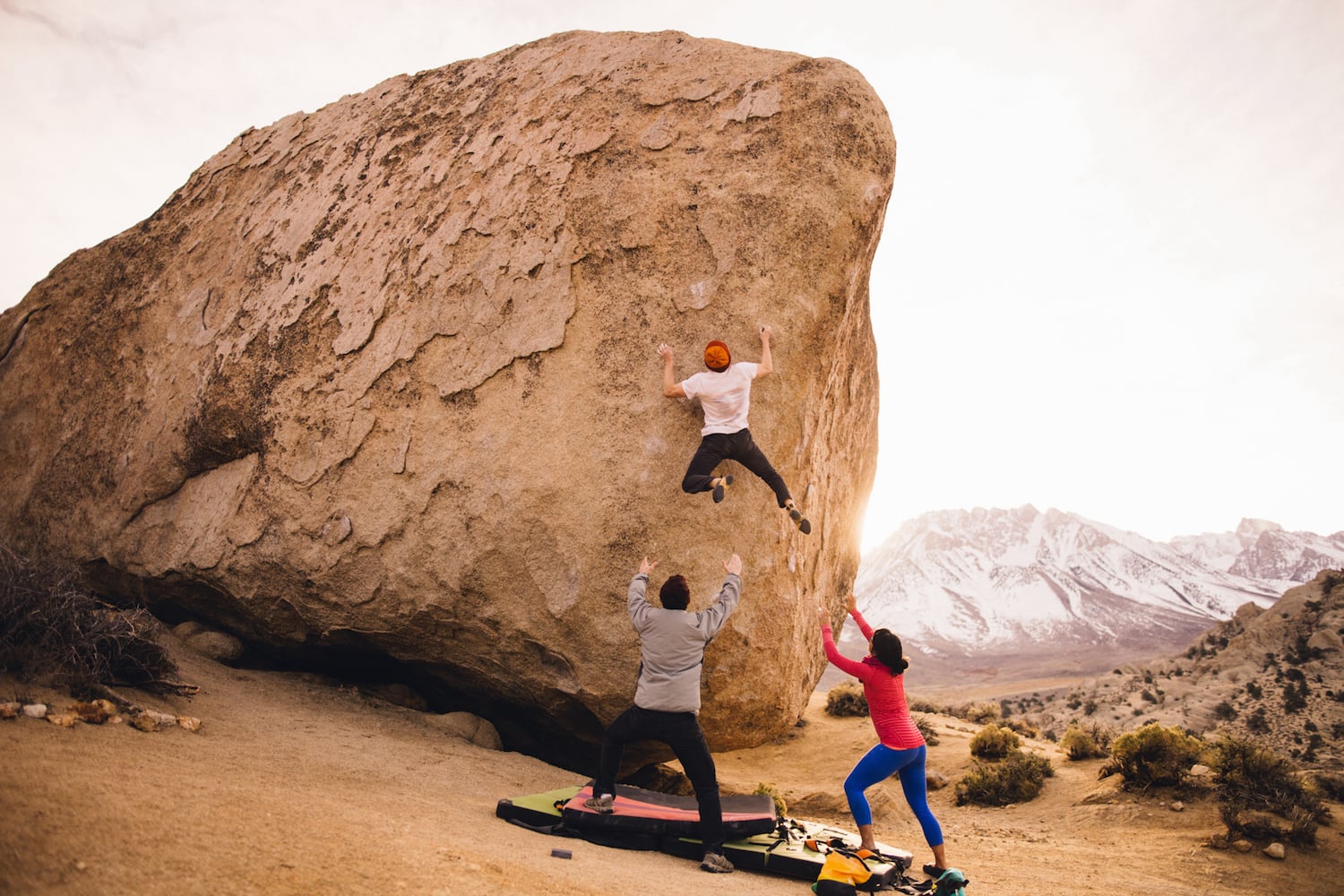
Published on: 03/26/2022
What Is Bouldering?
Bouldering is a style of free climbing performed outdoors on small natural rock formations or indoors on artificial walls without a rope or harness. Akin to child’s play, bouldering is the simplest form of rock climbing.
Bouldering comes without gear, belayer, and associated distractions. As such, it allows a climber to focus completely on the terrain and their movement. This simplicity and singular focus makes it easier to enter the Zen-like flow state that we may seek from climbing.
The sport of bouldering began as a way for climbers and mountaineers to train and warm-up for more “serious” climbing on taller cliffs and peaks. However, today bouldering is considered one of the major rock climbing disciplines by itself. It has bouldering competitions, legendary areas, sponsored rock stars, and its own culture and universe of gear.

A Loose Concept
There is no official definition of how tall a boulder problem can be before the climb becomes a free solo. Every individual climber is responsible for assessing a potential route and deciding whether they are comfortable attempting it without the security of a rope and gear to protect a fall.
This limit is a personal choice. For most people, it arrives between 10 and 20 feet, but elite boulderers push beyond the average climber’s comfort zone to summit giant blocks that may be over 40 feet (12 m) tall.
Bouldering is the most fundamental form of climbing because, at its simplest, it requires no gear and no partner. While modern bouldering usually involves a minimal amount of equipment, sending your boulder project completely naked is perfectly acceptable. In fact, it’s perhaps the purest style possible!
The Origins of Bouldering
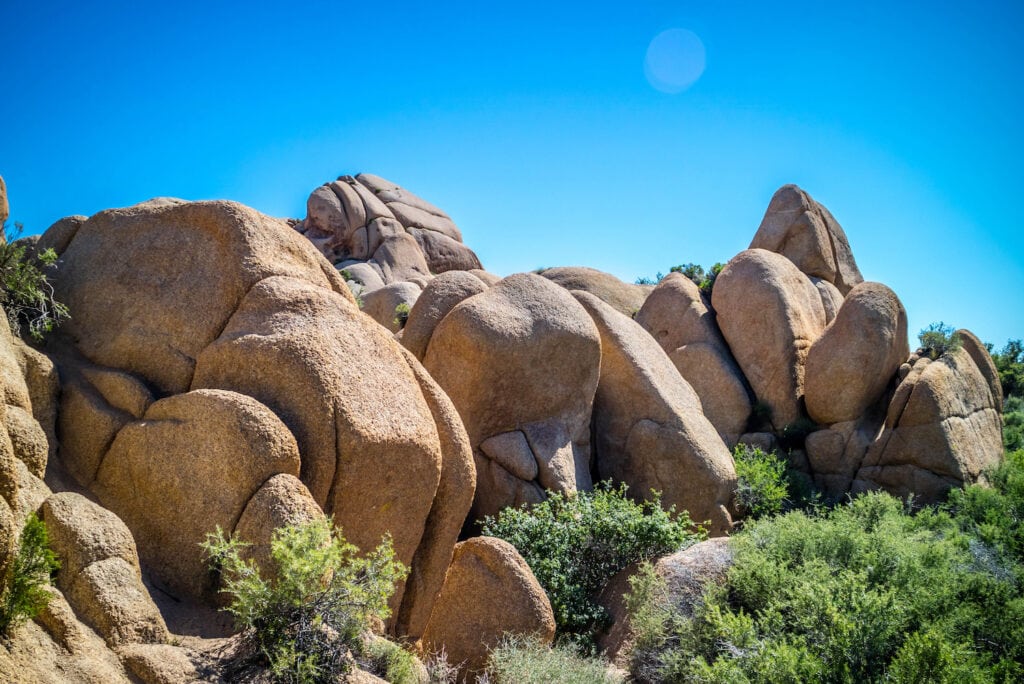
Humans have been bouldering for millennia. Climbing rocks to scout for game and watch for invaders, to make art, and probably just for the fun of it. But the modern version of bouldering first showed its form around 50 years ago.
As stated in the introduction, mountaineers and rock climbers of yore were grappling boulders well over a century ago. It’s impossible to verify exactly who did what in this murky history. There are recorded accounts and images of early climbers ascending small rock formations starting in the 1800s in the United Kingdom, the Italian Dolomites, Saxony in Germany, and the Fontainebleau area of France.
Even the infamous Aleister Crowley left behind a text description and topo drawing of a number of boulder problems on the still-climbed “Y Boulder” in England’s Lake District.
John Gill and “The Art of Bouldering”
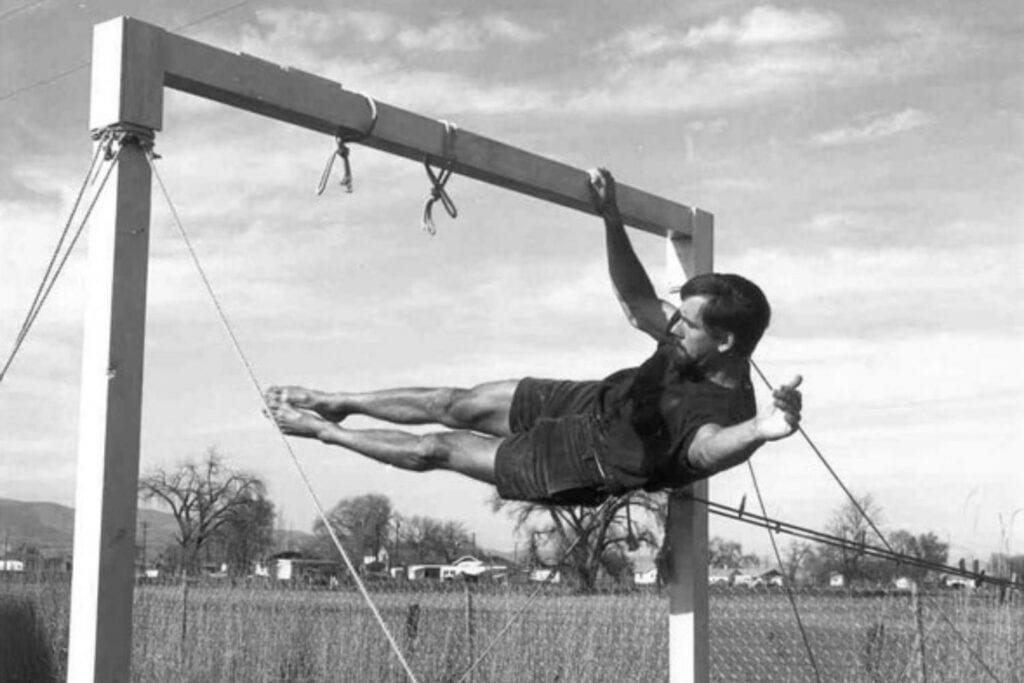
Some climbing historians trace the current concept of bouldering as an activity unto itself to the 1950s, and a mathematician and university professor with a background in gymnastics, John Gill.
Gill climbed mostly alone, without ropes, climbing shoes, or crash pads, throughout the western U.S. from the mid-1950s until the 2000s. He invented his own difficulty scale for rating boulder problems. He also pioneered the use of gymnastic chalk as a climbing aid (1).
In 1969 John Gill published, The Art of Bouldering (2), in The American Alpine Journal. In this brief essay, he explained the methods and philosophy he had developed. It culminated in this statement:
“Bouldering is essentially one-pitch rock climbing which emphasizes moves of very great difficulty.”

Gill also added the following important points:
- Falls are to be expected on a proper bouldering challenge
- Form should be prioritized over success
- Dynamic movement is not only allowed but encouraged.
Finally, he wrapped up this manifesto with a description of his idiosyncratic B-scale rating system.
Many renowned climbers spent time with Gill and were influenced by his ideas, from Yvon Chouinard and Royal Robbins to John Sherman and Peter Croft. Whether you accept the idea that he founded the discipline of modern bouldering or not, the aesthetics and ideals proposed by John Gill still resonate in the culture of modern-day bouldering.
Differences Between Bouldering and Roped Climbing
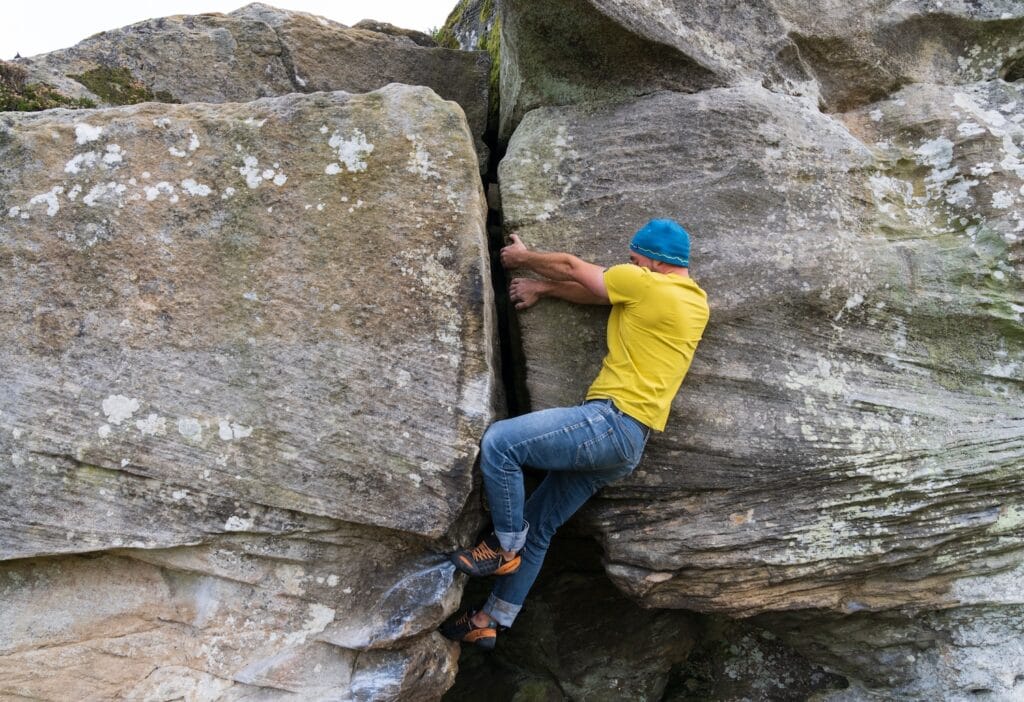
Equipment Requirements
The most obvious difference between climbing with a rope and without is the amount and types of gear used to practice these disciplines safely.
Roped climbs demand more gear, whether you’re sport or trad climbing, aid climbing, or ice climbing. At a minimum, sport climbers must haul a rope, harness, belay/rappel device, quickdraws, multiple carabiners in different flavors, a couple of slings, and several other items.
Tradsters can count on an additional burden of nuts, cams, more webbing, a nut tool, more carabiners, and more. Longer, more complicated routes may require even more gear. You may even need a bed to anchor to the wall so you can sleep!
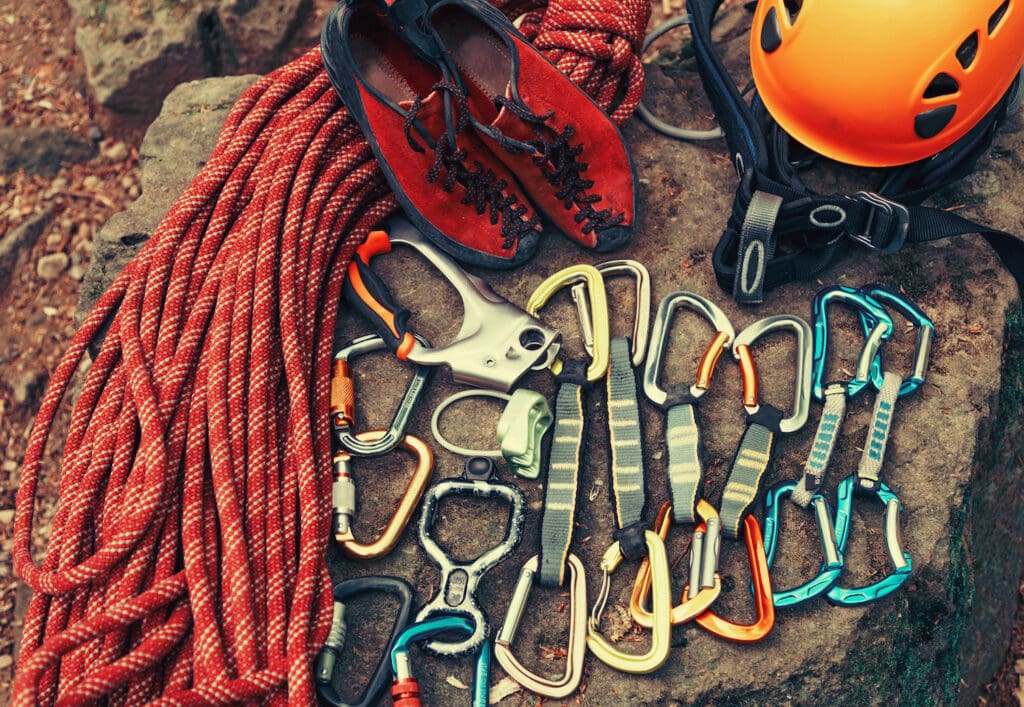
On the other hand, bouldering at its most basic requires no gear at all. It’s completely legitimate to hike up to a boulder and climb to the top in your sandals or tennis shoes.
For most though, bouldering at or near one’s limits is significantly safer with climbing shoes and chalk to enhance grip, a crash pad (or several) to soften landings and prevent injuries, and spotters to keep you from tumbling out of the safe landing zone.
Compared to other styles, bouldering requires very little equipment. Also, the gear should last you for many sessions at the gym or outdoors.
Risks and Injury
Is bouldering safer than other climbing disciplines? After all, most boulder problems don’t require you to climb higher than 10 to 15 feet (3 to 4.5 meters) off the ground. Many lead climbing falls in sport or trad are of similar length, before the leader is caught by their belayer. Hopefully without hitting a ledge, the ground, or some other hazard.
On the other hand, every time an unroped climber falls they have a 100% chance of hitting the ground. This is why thoughtful pad placement and experienced spotters are critical to safely tackling outdoor boulder problems.
In reality, the risk of serious injury or death is extremely low in most forms of climbing. It’s also true that there are numerous fatal accidents associated with roped climbing every year.
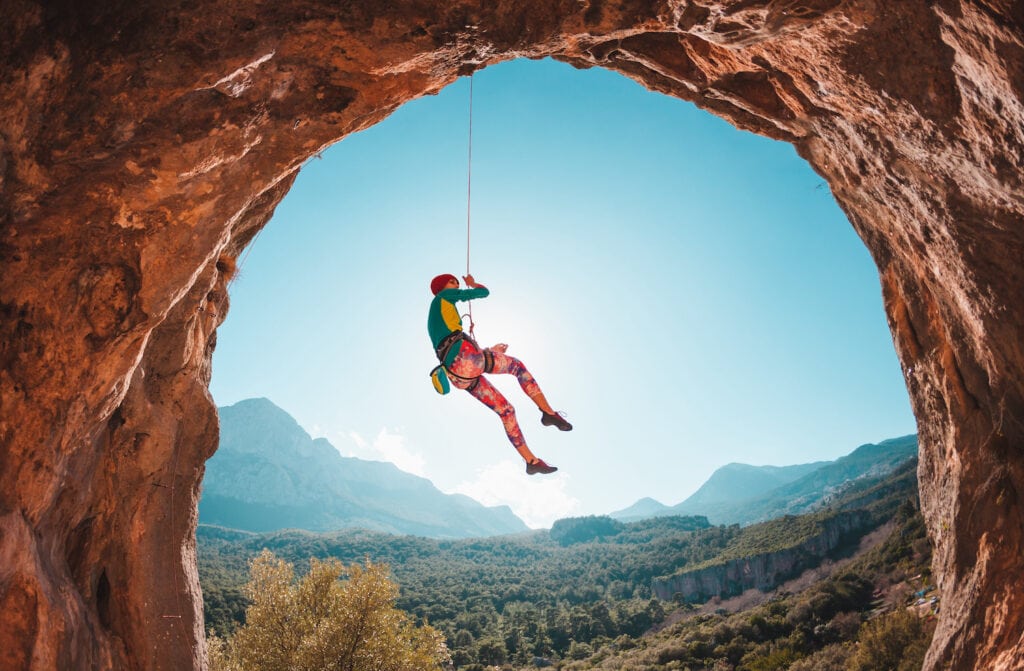
However, my research turned up only one confirmed death reported by parties engaged in bouldering throughout the years. In this incident, the victim pulled on a loose block that detached and struck the victim in the head as he fell.
Although you’ll probably not die bouldering, minor injuries are common. Sprained ankles, broken wrists, bruised elbows, and tailbones are some of the consequences of missing your crash pad or climbing without spotters. It’s difficult to know whether these injuries are more prevalent for boulderers, since they are generally not documented.
Considering all this, it’s reasonable to think of bouldering as more dangerous than sport or trad climbing. Indeed, every fall carries with it some chance of causing harm. Every climber must weigh the risks and rewards on their own.
Bouldering Lingo
As bouldering culture evolved over the years, it has developed its own vocabulary and slang terminology within the larger climbing community. Here are some terms you may want to know in order to communicate with the local bouldering population:
Boulder Problem
A defined line on a rock face that a climber ascends to reach the top; the equivalent of a “route” in roped climbing. Indoor boulder problems either have handholds and footholds marked with colored tape. Otherwise, the holds on each problem are all the same color.
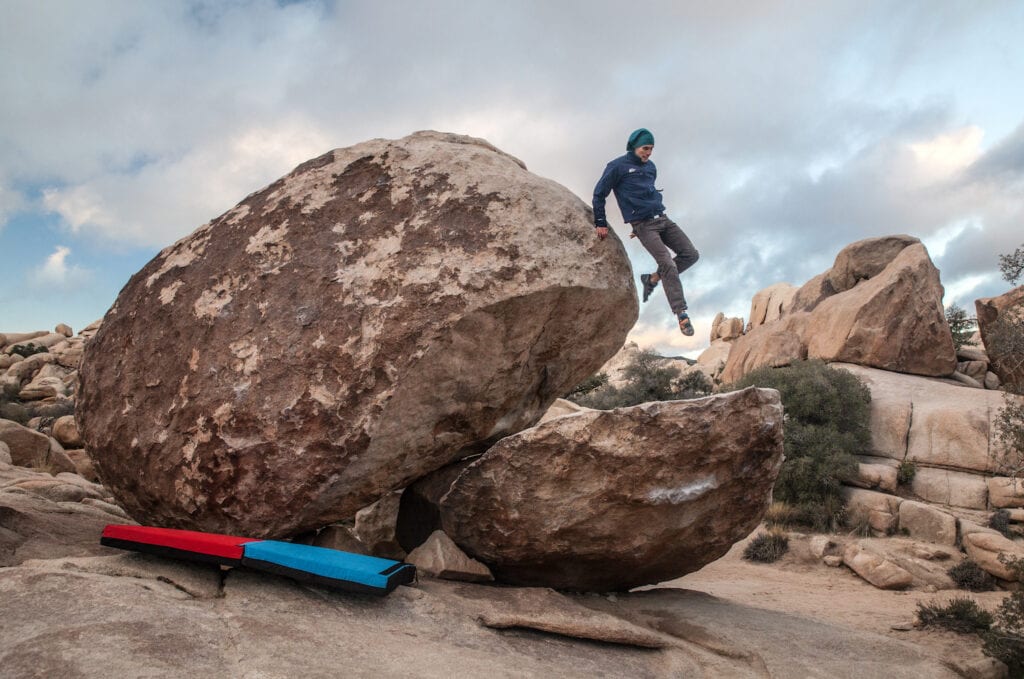
Crash Pad (aka Bouldering Pad)
A purpose-built, cushioned mat, usually constructed with foam inside of a fabric cover. Crash pads are essential tools in the modern practice of bouldering. Used to cover sharp rocks in the landing area and soften the impact of falls and jump-offs.
Crux
The hardest move or series of moves on a rock climbing route or a problem.
Dyno
A type of move that is more common in bouldering, during which a climber launches their body off the rock and loses all points of contact in order to reach a distant hand hold.
Flash
To successfully climb a boulder problem on one’s first attempt.
Highball
A boulder problem that tops out taller than the average, where a climber is more likely to risk injury in the event of a fall near the top. There is no standard, but most practitioners would consider highball bouldering to start around 15 feet (4.5 m) or thereabouts.
Project
Usually refers to a sport route or bouldering problem that a person is working on but hasn’t successfully completed.
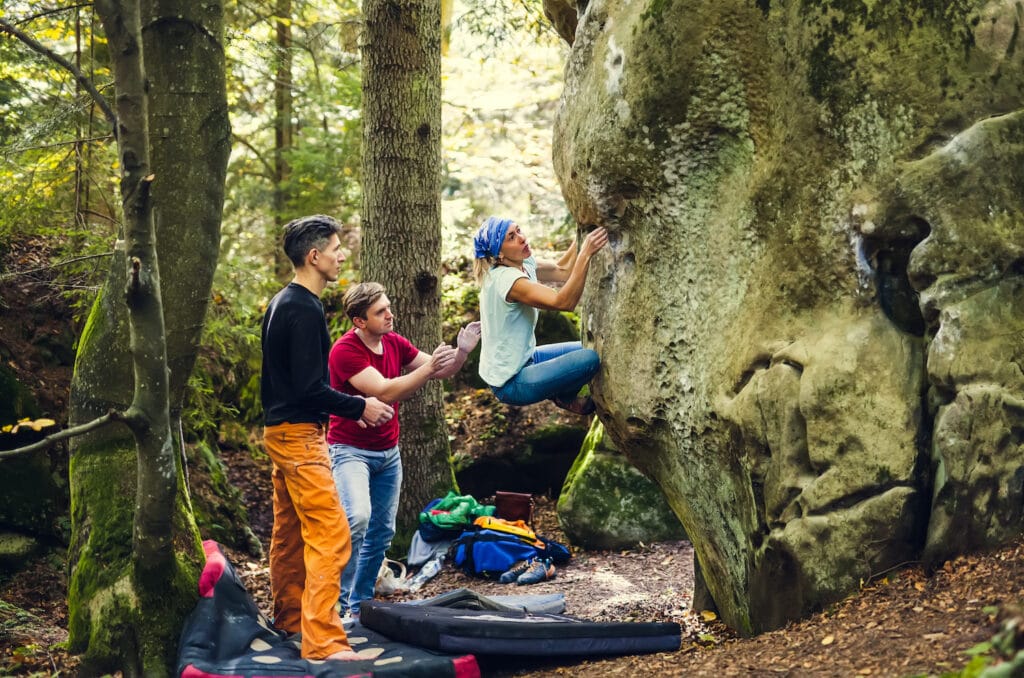
Send (noun), To send (verb)
To send means to complete a boulder problem without falling. Can be helpful as motivation when your spotters all yell, “Send it!” as you struggle on the crux. Also, used as a noun as in, “Sick send, my dude!”
Sit start
A problem that has starting holds so low on the rock that a climber must start the route with their butt on the ground.
Spotter
A person who stands on the ground under a boulder problem. They prevent a falling climber from falling off the bouldering pads or striking their head.
Top out (noun), To top out (verb)
A top-out is the final move of a problem that a climber must surmount to claim a successful send. “Watch the top out, it’s sandy and slopey.” Also, “topping out” refers to the act of completing the last move. It may require a mantle, a move that consists of going over a horizontal ledge.
Bouldering Grades and Rating Systems

When climbers began treating bouldering as its own unique discipline, they developed new systems for grading the difficulty of bouldering routes. The existing standards for rating technical rock and mountaineering routes didn’t make sense when applied to bouldering.
In America, John Gill invented the extremely subjective B-rating system that included just three grades: B1, B2, and B3. The highest grade, B3, is reserved for a problem that has only been done once. As soon as another climber repeats a B3 problem, it is downgraded to B2. Because this system is so wildly subjective and close-ended, it never caught on with the larger public.
The V-Scale
In the 1980s, the well-rounded climber John Sherman was creating new problems at an area called Hueco Tanks in Texas. It’s one of the proving grounds for the first generation of serious boulderers to come after Gill.
Sherman conceived of a new, open-ended rating system that became known as the V-scale. Starting at V0 and expanding up infinitely, the V-scale allows for stronger and better athletes to keep pushing the limits and adding more difficult climbs to the realm of possibility.
At the present moment, there are a number of agreed-upon V16 bouldering problems in various locations throughout the world. There are also two potential V17s that have yet to be repeated and confirmed.
In terms of the more familiar Yosemite Decimal System, a V0 boulder problem is equivalent to performing the most difficult moves on a 5.10a route. The moves on a V16 are considered somewhat equivalent to the difficulty of a 5.15c sport route. However, these grade conversions don’t mean much in the real world.
The Font Scale
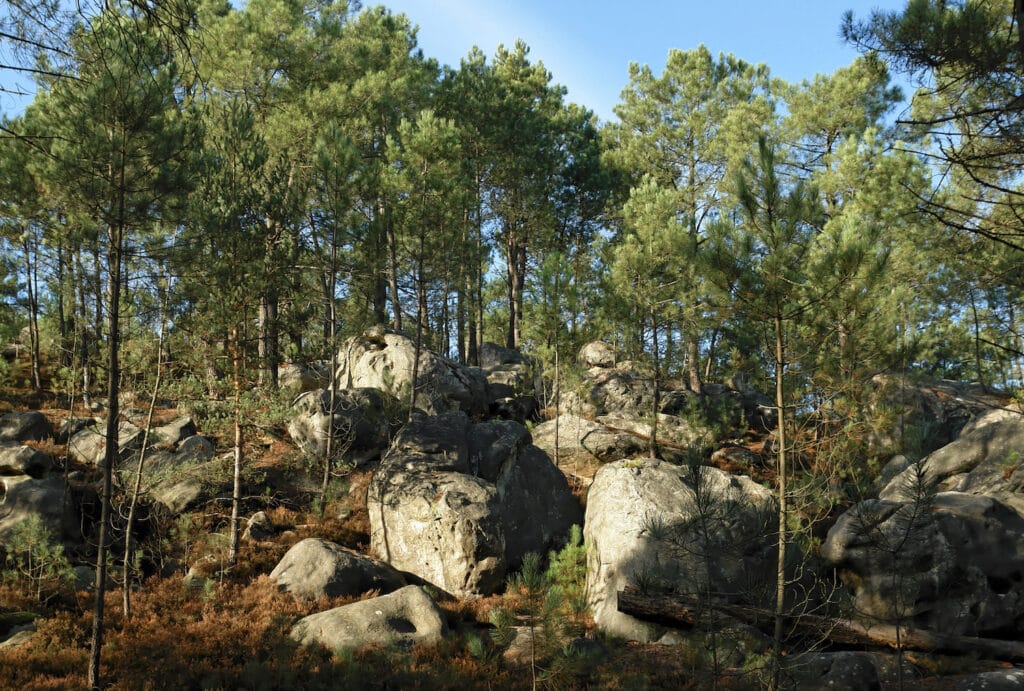
The Fontainebleau region south of Paris is another of the world’s shrines of bouldering.
As such, local climbers developed their own rating system named after the region, the Fontainebleau system, or Font for short. The Font scale, like the V-scale, is open-ended to accommodate future expansion.
At the moment, the Font scale starts at 1 and goes to 9a. Below you’ll find a chart that shows a comparison between the V- and Font scales.
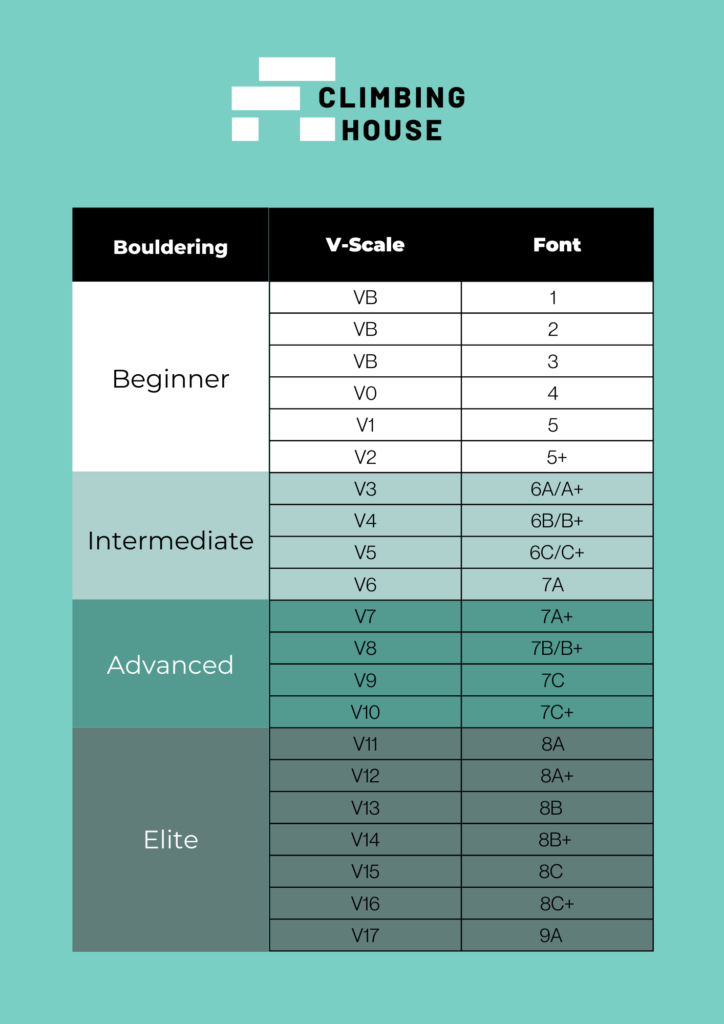
Additional Bouldering Rating Systems
The V-scale is prevalent throughout the Americas, China, and Australia, and the Font scale is employed in most European countries. Climbers in other regions have developed other grading systems and scales to suit their own needs, most notably in the United Kingdom and Japan.
You can read more about different grading systems for all the various climbing styles in our guide to climbing grades.
Indoor vs. Outdoor Bouldering

While the sport of bouldering evolved as an outdoor pursuit, practiced by climbers who started their careers with roped free climbing, nowadays there are probably more climbers who exclusively boulder in climbing gyms than outdoors.
No matter where you boulder, the climbs will be relatively short and demanding. Bouldering by its nature often requires more core and upper body strength to handle overhangs and roofs. It also demands superior grip strength to pull on small crimps and insecure slopers.
Bouldering at any level requires technical footwork skills: edging, smedging, smearing, scumming, toe hooking, heel hooking, and flagging.
Terrain
One of the foundational concepts of bouldering is that, because the climbs are so short, the moves should be difficult and intense. Therefore, boulder problems tend toward steep and overhanging rock.
This is true both indoors and out. Most dedicated bouldering gyms devote at least half of their space toward moderately to severely overhanging walls. While horizontal roofs are somewhat rare outdoors, they are a mandatory feature in today’s indoor bouldering facilities.
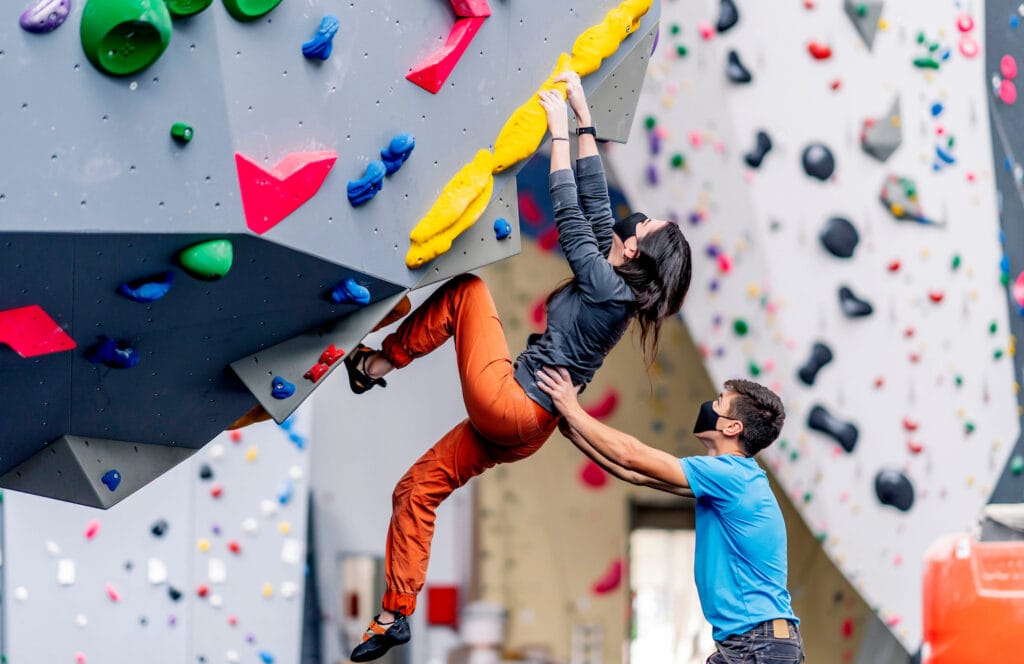
Difficulty and Grades
The general consensus says that indoor bouldering is subjectively “easier” than bouldering outdoors. For one thing, there’s no mental stress caused by worrying about hitting sharp objects in the landing area.
The holds on indoor bouldering walls are also clearly marked and visible, so it’s often easier to flash problems near your limit inside.
Many climbing gyms use the V-scale to rate the difficulty level of each problem. However, many also invent their own custom grading systems.
In any case, don’t expect indoor bouldering grades to necessarily correlate to outdoor ratings, or even to ratings at other indoor facilities. Some gyms and route setters grade problems softer, and some harder. So, just because you climb V5 consistently at one bouldering gym doesn’t mean you’ll enjoy the same level of success at another indoor wall or outdoors.
One benefit of indoor climbing is that you can more quickly achieve a strenuous workout by climbing a number of problems at a chosen grade in a short period of time. This can be difficult outside if boulders are spread apart and you have to pack up and move often.

Objective Risks and Environmental Hazards
Bouldering indoors offers a number of safety advantages over bouldering outdoors.
First, the landing area below indoor climbing walls is consistently flat, clear of obstacles, and usually constructed with thick padding under the carpet. Outdoor boulders have highly variable landing zones with steep slopes, sharp rocks, cacti, and other hazards that a falling climber must avoid.
Second, the holds on artificial bouldering walls are bolted to the underlying structure and extremely unlikely to come loose. The rock quality of natural stone is rarely that trustworthy. You should carefully check outdoor problems for loose and dirty holds before committing to a first ascent. Rock continues to weather and holds will continue to break, even on a classic climbing route that has seen thousands of sends.
Atmosphere
The experience of summiting a plywood-and-resin wall indoors is quite a bit different than climbing in the natural environment. Many people start rock climbing because of their attraction to nature and the scenic landscapes where crags and boulders are often located.
For people like that, to boulder indoors is merely an opportunity to meet other climbers and keep up with training routines. You can only experience the real magic of climbing in the solitude and tranquility of the natural world.
More and more climbers these days are starting their climbing careers indoors, however. Some gym climbers feel the urge to expand their horizons and explore the outdoor bouldering scene. However, many people feel no need to leave the sanctuary and community they find on the padded floor.
Notable Spots

Bouldering Gyms
The first generation of climbing gyms in North America focused on top-rope and lead sport climbing. The Spot in Boulder, Colorado is perhaps the first gym that was built almost exclusively for bouldering, in 2002.
There are now many gyms around the world dedicated solely to bouldering.
Renowned Outdoor Bouldering Locales
Following are some of the most famous and extensive bouldering areas around the world:
- Hueco Tanks State Park, Texas, USA (1,000+ documented bouldering problems)
- Fontainebleau, France (7,000+)
- Rocklands, South Africa (3,500+)
- Magic Wood, Switzerland (1,200+)
- Bishop, California, USA (1,390+)
- Joe’s Valley, Utah, USA (670+)
- Horse Pens 40, Alabama, USA (400+)
- Joshua Tree, California, USA (1,290)
How To Start Bouldering
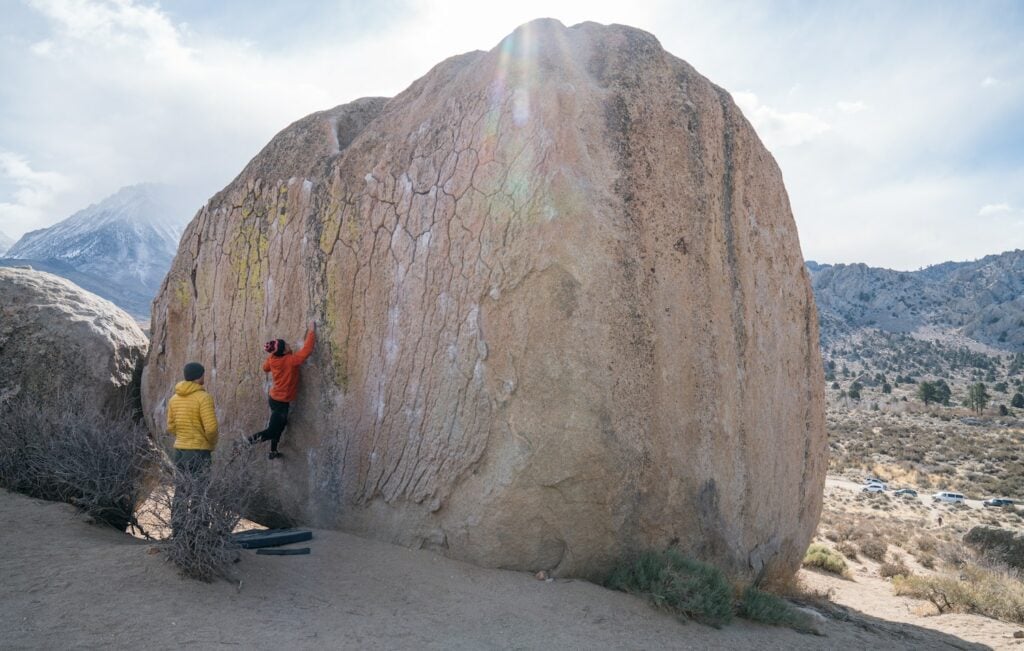
The quickest and safest path to sending your first boulder problems is to find an indoor climbing gym and take an introductory course.
If you don’t have a local facility for indoor bouldering, try to find a nearby climbing group through social media or online search and make contact. Often members of climbing clubs and organizations are willing to invite newcomers out to share their sport. Many universities also have climbing clubs that organize training classes and group trips.
But honestly, you don’t really need any classes or education to start bouldering outside. Search the internet for online guides, or buy a guidebook, and find an area that has a number of lower-rated problems (that is, V0 to V2). Ideally, find a partner to spot you and share in the fun.
Pack up your bouldering mats, rock shoes, chalk bag, and lunch and hit the trail. Your first bouldering adventure awaits!
Equipment Required for Bouldering
Required gear:
- Climbing shoes
- Chalk bag
Optional:
- Crash pads (only for outdoor bouldering; all gyms have them)
Best Climbing Shoes for Bouldering
You can climb boulders in any model or type of climbing shoes. However, the majority of problems are steep and have tricky or marginal footholds, so the bouldering elite favors softer, aggressively downturned shoes. More sensitive shoes are also more suitable in order to feel micro edges, pebbles, and ripples.
Most serious bouldering enthusiasts also like their shoes to have a tight fit, so there’s no looseness or sloppiness in the heel. That helps with heel hooks, and extra rubber over the top of a shoe’s toe box can make a toe hook more solid.
Check out our selection of the best bouldering shoes.
Training to Fall
Anyone who has climbed a ladder or a playground jungle gym already has the skills they need to top out a boulder problem. The process of going up is instinctual and rarely poses any danger.
As we’ve stated, though, bouldering also means falling. Or jumping down to the crashpad from the middle of a problem, when a climber doesn’t have the strength or confidence to top out and down climbing is difficult.
A novice climber should learn how to fall properly as one of their first tasks. Find a safe vertical to slightly overhung problem in the bouldering gym or outside. Safe meaning that you have padding in the form of a cushioned floor or an appropriate number of pads, and that you aren’t too high off the ground or awkwardly positioned.

Climb up just a foot or two off the ground, then loosen your grip and allow yourself to fall, springing back so you can stay upright and land on your feet. When you fall, keep your body vertically oriented if possible, with elbows and knees bent slightly and relaxed. Hit the ground with both feet and let your knees and hips bend to absorb the shock of landing.
Try this a few times from increasing distances until you feel completely secure and comfortable at each height. If you’re in a bouldering gym you should eventually be able to safely jump down from the top hold on all the problems.
If falling from a higher distance and the force of landing is too much for your knees, hips, and spine to handle, allow your body to collapse on impact and roll to one side from legs to hip to shoulder. This disperses the energy of the fall over a larger area.
If you lose your balance when you land a real-life fall, or you’re falling in an awkward position, your spotters should help re-orient your torso and support it so your head doesn’t strike the ground and you don’t fall off the pads.
Environmental Impacts

Good boulders and bouldering areas are often located away from trails and roads. That means boulderers must be especially aware of their impacts when traveling off-trail and placing bouldering pads on undisturbed ground.
Do your best to stay on established trails, and avoid the creation of new trails to any off-trail bouldering destination. In most places, creating a new path without official approval is prohibited. If building a trail is allowed, make sure and create one clear trail and discourage the forming of other paths.
Sometimes boulders have loose rock on an intended route, dirt and sand on the holds, or gravel on the top out. Preparing to climb a bouldering problem safely usually involves cleaning the dirt and debris from hand- and footholds, and removing loose rock as a safety precaution.
If you use your hands or a brush to clean the rock, minimize or avoid damaging living organisms like lichen, moss, and grasses that are growing on the stone or in crevices. The same goes for spider webs, packrat nests, and the homes of other native creatures.
When it comes to placing bouldering mats at the bottom of a problem, don’t do anything to cause permanent harm to the plants on the ground. Grass may be able to recover from being temporarily flattened once in a while, but repeatedly smashing it with multiple pads will transform the base of any climb into bare dirt.
Be conservative with your use of chalk outdoors, and do your best to clean off your chalk marks when you leave. This is even more important in arid environments and on overhanging rock, where there’s little rain or snow to help wash away the signs of our presence.
Important Tips
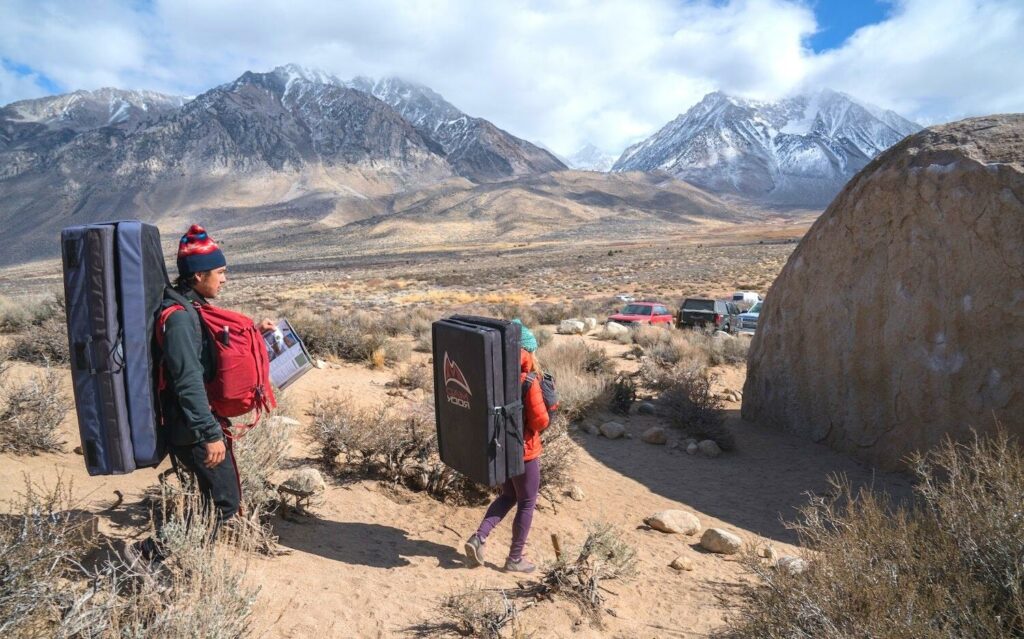
What to Wear When Bouldering
Wear loose clothing or shorts that allow you to move freely. If outdoors, be ready for changing conditions and bring extra layers during colder seasons. Bouldering at a high level involves a lot of sitting around and resting between burns, and you want to stay warm.
Take Frequent Rest Breaks
Especially for indoor climbers, it’s easy to get excited about the convenient access to dozens of problems concentrated in a small area. Newcomers often throw themselves at one route after another, not realizing until it’s too late that they’re completely thrashed within the first 20 minutes. Force yourself to rest for five minutes after every climb or attempt that’s near your peak performance limit.
Frequently Asked Questions (FAQs)
It’s not easy to compare. Longer climbs can require more sustained effort, with peak difficulties or crux moves that are just as hard as bouldering moves. However, on great boulder problems, every single move is close to the overall difficulty. As a result, there are no rests or easy sections. The scales for rating boulder problems start at a higher level of difficulty than the scales for other technical styles. That’s the reason why beginners commonly perceive bouldering as more challenging initially. This is especially true of bouldering outdoors.
No, many climbers climb in the gym and outdoors alone. If you choose to climb outside solo, be extra careful selecting problems with flatter landings and don’t climb higher than you can safely fall without a spotter. Solo outdoor climbers can also mitigate risk by sticking to traverses where it’s possible to stay relatively close to earth.
A V4 boulder problem is considered intermediate level by experienced climbers. The moves on a V4 problem are similar to the moves on a 5.12a sport route. Most non-climbers and beginners would find a V4 problem extremely difficult or impossible to ascend.
It’s common to see bouldering walls in gyms up to 15-20 feet. However, for safety reasons, the staff is unlikely to set routes that high—they tend to limit them to 13 feet. Beware of bouldering gyms that set routes higher than that!
References
1. Eiger Dreams
Jon Krakauer (1990)
ISBN 0-385-48818-1
https://en.wikipedia.org/wiki/Eiger_Dreams
2. The Art of Bouldering
John P. Gill (1969)
American Alpine Club
http://publications.americanalpineclub.org/articles/12196935500
